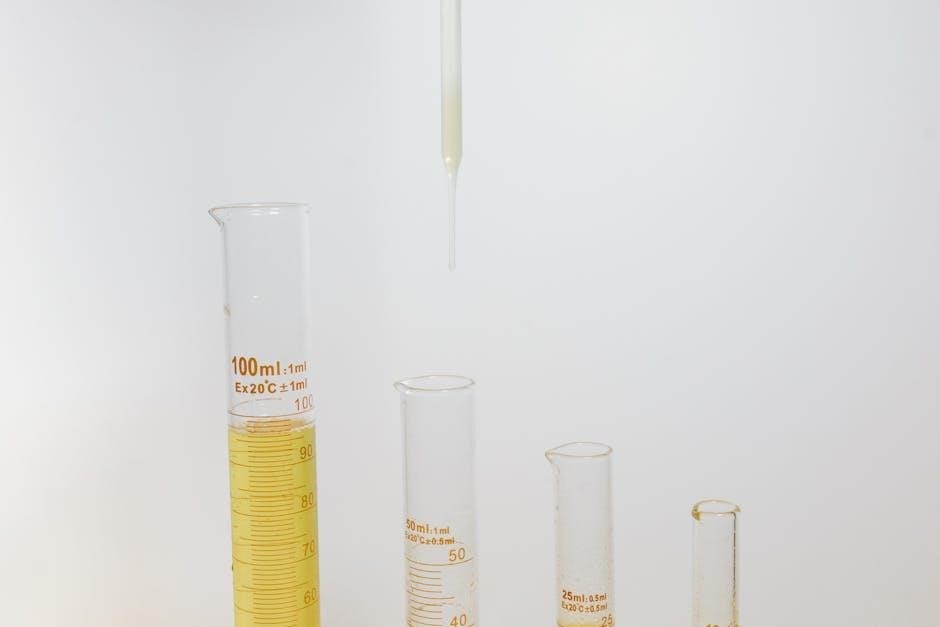volume of prisms and cylinders worksheet pdf

Understanding the volume of prisms and cylinders is fundamental in geometry, enabling calculations for various real-world applications, from construction to engineering, by measuring space occupancy.
1.1 Definition of Prisms and Cylinders
A prism is a three-dimensional shape with two identical polygonal bases connected by rectangular faces. The base can be any polygon, such as a rectangle, triangle, or hexagon. A cylinder, on the other hand, is a three-dimensional shape with two congruent circular bases connected by a curved surface. Both prisms and cylinders have a height, which is the distance between their bases. These shapes are fundamental in geometry, as they form the basis for calculating volumes in various real-world applications. Understanding their definitions is crucial for applying volume formulas effectively.
1.2 Importance of Calculating Volume
Calculating the volume of prisms and cylinders is essential for various practical applications, such as engineering, architecture, and everyday problem-solving. Volume determines the space occupied by an object, aiding in material cost estimation, storage planning, and design optimization. In construction, accurate volume calculations ensure structural integrity and resource efficiency. In manufacturing, it helps in product design and quality control. Additionally, volume calculations are crucial in fields like physics and chemistry for understanding density and mass. Mastery of these skills enhances mathematical proficiency and real-world problem-solving abilities, making it a foundational concept in STEM education.

Formulas for Volume Calculation
Volume of prisms and cylinders is calculated using specific formulas. For prisms, it’s base area multiplied by height (V = Bh), while cylinders use πr²h for volume calculations.
2.1 Volume of a Rectangular Prism
A rectangular prism is a three-dimensional shape with six rectangular faces. To find its volume, you multiply its length, width, and height. The formula is:
V = lwh, where l is length, w is width, and h is height. This formula calculates the space inside the prism. For example, if a prism has a length of 5 cm, width of 3 cm, and height of 2 cm, its volume is 30 cm³. This method is foundational for understanding more complex volume calculations.
2.2 Volume of a Triangular Prism
A triangular prism is a three-dimensional shape with two identical triangular bases and three rectangular faces. To calculate its volume, you first find the area of the triangular base using the formula:
A = (base × height) / 2. Then, multiply this area by the length (or height) of the prism. The overall formula is:
V = (base × height / 2) × length. For example, if the base is 4 cm, the height of the triangle is 5 cm, and the prism’s length is 6 cm, the volume is:
V = (4 × 5 / 2) × 6 = 60 cm³. This method is essential for solving problems involving triangular prisms in various applications.
2.3 Volume of a Cylinder
The volume of a cylinder is calculated by finding the area of its circular base and then multiplying by its height. The formula is:
V = πr²h, where “r” is the radius of the base, and “h” is the height. For example, if the radius is 3 cm and the height is 5 cm, the volume is:
V = π × 3² × 5 = 45π cm³. This formula is widely used in real-world applications, such as engineering and construction, to determine capacities and dimensions of cylindrical objects.

Types of Prisms
Prisms are categorized based on their base shapes, such as rectangular, triangular, pentagonal, and hexagonal prisms, each with unique properties for volume calculations.
3.1 Rectangular Prisms
A rectangular prism, also known as a cuboid, is a three-dimensional shape with six rectangular faces, eight vertices, and twelve edges. Its volume is calculated by multiplying its length, width, and height. The formula for the volume of a rectangular prism is ( V = l imes w imes h ), where ( l ) is the length, ( w ) is the width, and ( h ) is the height. This formula is foundational for understanding more complex shapes and is widely used in real-world applications, such as construction and packaging. Worksheets often include problems involving rectangular prisms to help students master the concept of volume calculation through structured practice and visualization.
3.2 Triangular Prisms
A triangular prism is a three-dimensional shape with two congruent triangular bases connected by three rectangular faces. To calculate its volume, first, determine the area of the triangular base using the formula: Area = (1/2) * base * height. Then, multiply this area by the height of the prism (the distance between the two triangular bases). This method applies universally to all types of triangular prisms, whether they are right, isosceles, scalene, or equilateral. Worksheets often include problems involving triangular prisms to help students master volume calculation through structured practice and visualization of the shape’s dimensions and properties.
3.3 Other Polygons as Bases
Beyond rectangular and triangular bases, prisms can also have bases shaped like other polygons, such as pentagons, hexagons, or irregular polygons. The volume calculation remains consistent: it is the product of the base area and the height of the prism. For regular polygons, the base area can be found using specific formulas, while irregular polygons may require dividing them into simpler shapes like triangles or rectangles. These prisms are essential in various architectural designs and engineering applications, offering unique structural properties. Worksheets often include problems involving diverse polygonal bases to help students apply the volume formula across different scenarios, reinforcing their understanding of spatial geometry and its practical uses. This variety enhances problem-solving skills and mathematical adaptability.

Practical Applications of Volume Calculations
Volume calculations are essential in engineering, construction, and manufacturing for designing structures, estimating materials, and optimizing space, making them vital in real-world problem-solving scenarios.

4.1 Real-World Uses of Prisms
Prisms are widely used in optics, medical devices, and architecture. They are essential in refracting light, creating precise angles, and enhancing structural stability in buildings and bridges, showcasing their versatility in practical applications.
4.2 Real-World Uses of Cylinders
Cylinders are integral to numerous industries, including engineering, automotive, and construction. They are used in engines as combustion chambers, in hydraulic systems for lifting heavy loads, and as structural components in buildings. Cylinders also play a role in transportation, such as in train wheels and airplane fuselage designs. Additionally, they are used in medical equipment like oxygen tanks and in household items such as water heaters. Their circular cross-section provides strength and stability, making them ideal for applications requiring durability and uniformity. Understanding cylinder volume is crucial for designing efficient systems across these diverse fields.

Benefits of Using Worksheets
Worksheets provide structured learning, helping students master volume calculations through practice. They offer clear examples, reinforce formulas, and build confidence in solving geometric problems effectively and systematically.
5.1 Structured Learning
Worksheets provide a clear framework for mastering volume calculations, offering step-by-step examples and exercises. This structured approach ensures students understand and apply formulas correctly. By breaking down problems into manageable parts, worksheets help learners grasp concepts at their own pace. The organized format reduces overwhelm, allowing focused practice on specific skills like calculating the volume of prisms and cylinders. With structured learning, students can systematically progress from basic to complex problems, reinforcing their understanding of geometric principles. Additionally, worksheets often include visual aids and real-world applications, making abstract concepts more tangible. This methodical approach fosters confidence and fluency in solving volume-related problems, preparing students for advanced mathematical challenges.
5.2 Practice and Reinforcement
Practice is essential for mastering volume calculations, and worksheets provide an effective way to reinforce learning. By repeatedly solving problems, students develop fluency in applying formulas for prisms and cylinders. Worksheets offer a variety of exercises, ensuring students encounter different scenarios and challenges. This repetition helps solidify understanding and builds confidence. Additionally, worksheets allow students to identify and correct common mistakes, fostering a deeper grasp of the concepts. With consistent practice, students can apply their knowledge to real-world problems seamlessly. Answer keys often accompany worksheets, providing immediate feedback and reinforcing correct methods. This structured practice ensures long-term retention of skills in calculating volumes of prisms and cylinders.

Solving Volume Problems
Solving volume problems involves understanding formulas, applying them accurately, and interpreting results. Practice with worksheets helps refine skills and avoid calculation errors, ensuring precise solutions consistently.
6.1 Step-by-Step Approach
A step-by-step approach is essential for accurately solving volume problems. First, identify the shape (prism or cylinder) and gather all necessary measurements. For prisms, calculate the area of the base by using the appropriate formula for its specific type, such as rectangular or triangular. Multiply the base area by the height to find the volume. For cylinders, use the formula V = πr²h, where r is the radius and h is the height. Always ensure units are consistent and round answers as required. This methodical process minimizes errors and enhances understanding.
6.2 Common Mistakes to Avoid
When solving volume problems, several common mistakes can lead to incorrect answers. One frequent error is using incorrect formulas, such as confusing the volume of a prism with that of a cylinder. Ensure the formula V = Bh is used for prisms, where B is the base area, and V = πr²h for cylinders. Another mistake is improper unit conversion, so always verify that measurements are consistent. Additionally, students often misapply the base area calculation, especially for triangular or irregular bases. Rounding too early in calculations can also introduce errors. Finally, neglecting to label answers with appropriate units is a common oversight. Double-checking each step and formula application helps mitigate these issues and ensures accuracy.

Resources for Learning
Explore mathworksheets4kids.com and Kuta Software for practice worksheets. Corbettmaths offers video tutorials, while Teachers Pay Teachers provides diverse educational resources for volume calculations.
7.1 Recommended Worksheets
For effective learning, mathworksheets4kids.com offers a variety of free printable worksheets on volumes of prisms and cylinders. These resources provide structured exercises, formulas, and step-by-step solutions, catering to different skill levels. Kuta Software’s Infinite Geometry tool allows customization of worksheets, ensuring personalized practice. Additionally, Corbettmaths provides video tutorials and practice sheets, while Teachers Pay Teachers offers diverse educational materials. These worksheets cover rectangular, triangular, and other polygon-based prisms, as well as cylinders, helping students grasp the formulas and applications. They are ideal for reinforcing concepts and improving problem-solving skills in geometry.
7.2 Online Tools and Calculators
Utilizing online tools enhances learning and problem-solving efficiency for volume calculations. Websites like Corbettmaths offer video tutorials and interactive resources. Math-Aids provides printable worksheets and calculators, while Kuta Software allows generating custom practice sheets. These tools cover prisms and cylinders, offering step-by-step solutions and real-time feedback, making them invaluable for both students and educators aiming to master geometry concepts effectively.

Advanced Topics in Volume Calculation
Exploring composite shapes and irregular forms challenges learners to apply foundational concepts creatively, often requiring decomposition into simpler prisms or cylinders for accurate volume determination.
8.1 Composite Shapes
Composite shapes, formed by combining simpler prisms or cylinders, require advanced techniques for volume calculation. The key principle involves breaking the shape into recognizable components, calculating each volume separately, and summing them. This method ensures accuracy and simplifies complex structures. For instance, a shape combining a rectangular prism and a cylinder can be tackled by finding the volume of each part individually. Challenges arise in identifying distinct components and ensuring measurements align properly. Practicing with diverse composite shapes enhances problem-solving skills and prepares learners for real-world applications in engineering and architecture. Worksheets often include such problems to reinforce mastery of volume concepts.
8.2 Irregular Shapes
Calculating the volume of irregular shapes presents unique challenges due to their non-uniform forms. Unlike regular prisms or cylinders, irregular shapes don’t fit standard formulas, requiring innovative approaches. One effective strategy is to decompose the shape into simpler, recognizable components, such as combining prisms or cylinders. By calculating the volume of each part separately and summing them, you can determine the total volume. This method ensures accuracy and simplifies complex structures. Worksheets often include exercises on irregular shapes to enhance problem-solving skills and prepare learners for real-world applications in fields like engineering and architecture. Regular practice with diverse irregular shapes helps refine these advanced volume calculation techniques.

Mastery of volume calculations for prisms and cylinders enhances problem-solving skills, with practical applications in various fields, encouraging continued learning and mathematical proficiency;
9.1 Summary of Key Concepts
The volume of prisms and cylinders is calculated using specific formulas; For prisms, the volume is the product of the base area and height, while cylinders use the formula V = πr²h. These concepts are essential for understanding three-dimensional shapes and their applications in real-world scenarios. Worksheets and practice problems help reinforce these formulas, ensuring accuracy and proficiency. By mastering these calculations, students gain a solid foundation in geometry, which is crucial for advanced math and science. Regular practice with worksheets tailored to different skill levels enhances problem-solving skills and builds confidence in handling complex shapes and measurements.
9.2 Encouragement for Further Practice
Consistent practice with volume calculations strengthens mathematical fluency and problem-solving skills. Utilizing worksheets and online tools provides hands-on experience, helping to solidify understanding. Encourage learners to explore various resources, such as printable PDFs and interactive calculators, to deepen their knowledge. Regular practice not only builds confidence but also prepares students for more complex challenges in geometry and related fields. By continuing to engage with these exercises, individuals can master the concepts of prisms and cylinders, laying a strong foundation for future academic success.